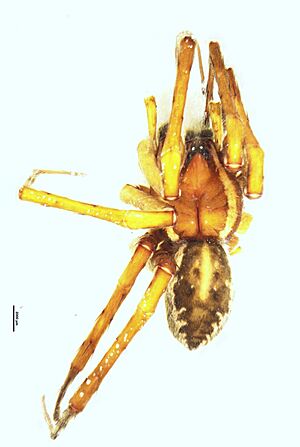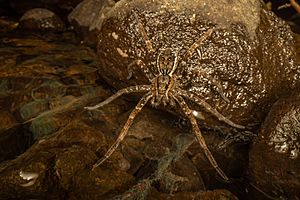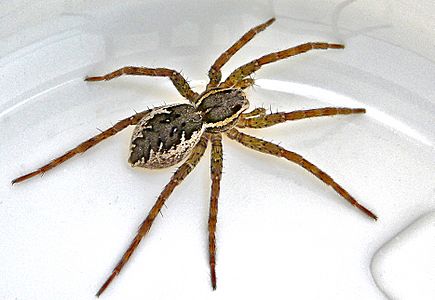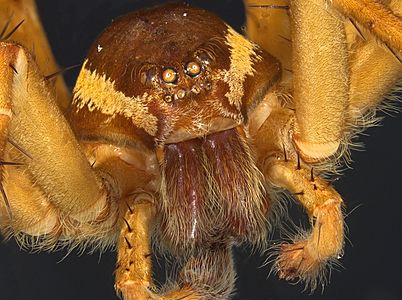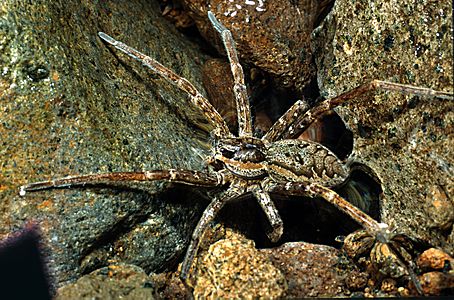Dolomedes dondalei facts for kids
Quick facts for kids Dolomedes dondalei |
|
|---|---|
 |
|
| At Kaimai-Mamaku Forest Park in Bay of Plenty | |
| Scientific classification |
The Dolomedes dondalei is a super cool spider found only in New Zealand. It's a type of large fishing spider, which means it's really good at hunting near or on water. This spider is a night hunter, using special skills to catch its food. It can even catch small fish, which is pretty unique among New Zealand spiders!
Contents
Discovering the Dolomedes dondalei
For a while, scientists knew about this spider but just called it Dolomedes III. It finally got its official name, D. dondalei, in 2010. Two scientists, Cor J. Vink and Nadine Dupérré, named and described it.
They named the spider after Dr. Charles Dondale. He was a spider expert who helped them a lot with their work. The very first male spider of this type, called a type specimen, was found by Vink in 2003. It's now kept at Lincoln University in New Zealand.
What Does It Look Like?
The Dolomedes dondalei is one of four similar spider species in New Zealand. It can grow quite large, up to 7 centimeters (about 2.7 inches) across, if you include its long legs!
It has dark orange-brown body parts near its head and chest, called the cephalothorax. You can spot it by the yellow stripes on this part. It also has light yellow-brown stripes along each side of its body, with patches that reach towards the middle.
Males are usually 12–18 millimeters long, while females are a bit bigger, 18–25 millimeters long. These spiders are super light, weighing less than a gram. They also have special hairs that repel water. This amazing feature lets them walk right on top of the water without sinking!
Where Does It Live?
This spider is endemic to New Zealand. This means you can only find it there! It lives all over the North Island and South Island.
Unlike some of its relatives, the D. dondalei loves shady places. It prefers waterways surrounded by native forests or thick plants. You'll often find it hiding under rocks close to rivers. The best time to spot adult spiders is usually in December and January.
How It Hunts and Survives
The D. dondalei is a night owl! It's most active about two hours after the sun goes down. During the day, it hides under stones and logs to stay safe.
When it hunts, it goes to the water's edge. It places its front legs on the water surface. Sometimes, it anchors itself to the shore with its back legs and lets its body float. It uses long, sensitive hairs on its legs to feel for tiny movements or vibrations on the water.
Once it feels something, it glides out onto the water. It can even use a silk safety line to stop itself from going too far! This clever hunting style allows it to catch insects and even small fish. It's the only New Zealand Dolomedes spider known to catch fish in experiments!
To escape from danger, this spider is a great diver. It can dive underwater and hide between stones. It can even stay underwater for up to half an hour! It does this by trapping air on its hairy body, like a tiny scuba tank.
D. dondalei spiders also eat other spiders. Sometimes, after mating, female spiders might even eat the smaller males.
These spiders do have some enemies. Certain parasitic wasps, like the Cryptocheilus australis and Sphictostethus nitidus, hunt them. These wasps can even chase the spiders underwater! They sting and paralyze the spider, then drag it to a nest to feed their young. Also, the egg sacs of D. dondalei are a favorite food for baby fernbirds.
Gallery


